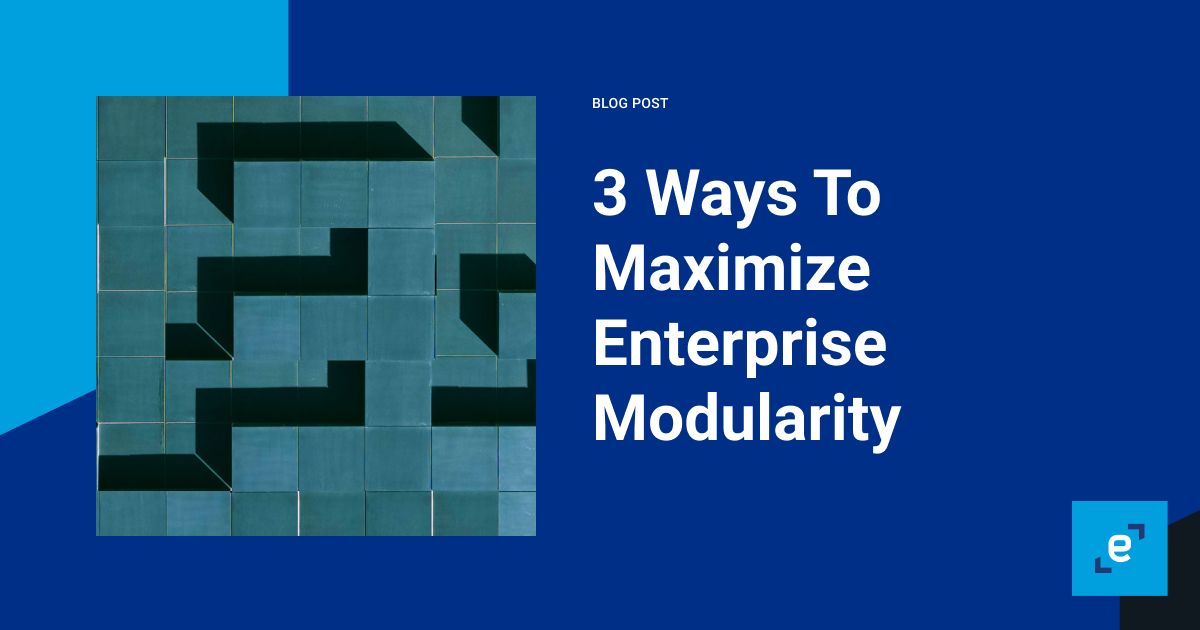
3 Ways To Maximize Enterprise Modularity
A modular enterprise architecture helps you maintain speed while improving your web apps. Here are 3 ways to get the most out of it.
While the conversation about modular architectures has recently seemed to come full circle, with some advocating for more monolithic architectures (particularly with regard to the frontend), modularity isn’t going anywhere in the enterprise space. When you scale up your organization and are dealing with large teams, user bases, and feature demands, modularity is the best way to manage complexity while staying nimble.
That isn’t to say that modular architectures don't have their own challenges. While modularity allows you to distribute your teams and give them independence, it introduces complexity all its own. Nevertheless, if you’re able to successfully navigate that complexity, you’ll go further faster than a more monolithic architecture would have been able to take you.
Here are 3 ways to get the most out of modularity in your enterprise architecture.
1. Use micro frontends to ensure that modularity extends to the frontend.
One of the best ways to ensure that your organization is to ensure that your architecture is modular from end to end. You may have backend modularity and an effective deployment model, but for many organizations, the frontend monolith remains. This is where micro frontends can help you more deeply embed modularity throughout your architecture. More than a distributed frontend monolithic, micro frontends help you to create better isolation between different pieces of frontend functionality.
By developing with micro frontends that connect to microservices in a Kubernetes environment, you are able to create a “micro stack” centered on a particular business function, giving your teams end-to-end control over that business function. These vertical slivers within your architecture are independently deployable, scalable, and updateable.
2. Ensure that your organizational structure supports your software architecture.
As you create projects with a modular architecture from the database all the way up to the frontend, you’ll also want to make sure that your organizational structures are congruent with that methodology. You want to make sure that your teams are able to enjoy the independence that the architecture affords them. In addition to a modular architecture, you need a modular organization.
That means that as you are able to break up pieces of functionality into isolated bits of code, you’ll want to ensure that your teams remain small. There isn’t necessarily a magic number that you want to keep yourself to. Though, Amazon is somewhat famous for their “two-pizza” rule that states that no team will be larger than two pizzas can feed for dinner.
This decision to keep your teams independent and small is an important strategy in making sure that the speed of decisions remains high and that teams are able to address business needs and deploy updates as soon as possible.
3. Use a platform to help you manage complexity.
While end-to-end modularity in your application architecture solves a number of issues for your organization, it also introduces a fair bit of complexity to your application’s overall code. This is where some enterprise architects might feel some hesitation. So you want to ensure that your teams have the tools they need to facilitate the orchestration and coordination of frontend and backend updates. This is where a modular application platform like Entando can really help your enterprise.
With Entando, you’re able to create a repeatable application architecture and make lower risk, micro updates. You can also increase the overall speed of your organization while maintaining a high quality of work and full alignment with the business requirements of the project. This helps you in your ongoing evolution in your DevOps journey.
Builder better apps faster with Entando.
When release cycles take months instead of weeks, your business is left unable to deliver modern online experiences. Development and deployment bottlenecks slow your ability to make application updates, keeping you from iterating and innovating. And outdated or clunky UX keeps you from winning customers over and retaining them.
So that’s why we created a platform to help you get your ideas to market faster.
Entando is the leading modular application platform for building enterprise web apps on Kubernetes. We want to change the way enterprises think about building their apps, sites, and portals in order to innovate more quickly with parallel development teams that have end-to-end control across the entire stack
With Entando, you can:
- Leverage customized blueprints using the Entando Component Generator (built on JHipster) to quickly create micro frontends and assemble them into an app.
- Reuse UI/UX components across multiple projects via the Entando Component Repository, saving money and increasing development speed.
- Scale apps quickly and effectively with Entando’s custom Kubernetes operator, automating the deployment of high availability, self-healing applications.
- Centrally manage user roles with Entando Identity Management (built on Keycloak).
Entando is open source with available enterprise support and services. Begin developing on the platform today, and get a quote to see how our team can help your enterprise build better apps, sites, and portals--faster.

